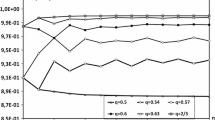Abstract
We consider 3-candidate elections under a general scoring rule and derive precise conditions for a given voting situation to be strategically manipulable by a given coalition of voters. We present an algorithm that makes use of these conditions to compute the minimum size M of a manipulating coalition for a given voting situation. The algorithm works for any voter preference model — here we present numerical results for IC and for IAC, for a selection of scoring rules, and for numbers of voters up to 150. A full description of the distribution of M is obtained, generalizing all previous work on the topic. The results obtained show interesting phenomena and suggest several conjectures. In particular we see that rules “between plurality and Borda” behave very differently from those “between Borda and antiplurality”.
Similar content being viewed by others
References
Aleskerov FT, Kurbanov E (1999) A degree of manipulability of known social choice procedures. In: Alkan A., Aliprantis C., Yannelis N. (eds) Current trends in economics: theory and applications. Springer, Berlin, pp 13–27
Chamberlin JR (1985) An investigation into the relative manipulability of four voting systems. Behav Sci 30(4):195–203
Favardin P, Lepelley D (2006) Some further results on the manipulability of social choice rules. Soc Choice Welf 26:485–509
Favardin P, Lepelley D, Serais J (2002) Borda rule, Copeland method and strategic manipulation. Rev Econ Des 7:213–228
Gibbard A (1973) Manipulation of voting schemes: a general result. Econometrica 41:587–601
Huang HC, Chua VCH (2000) Analytical representation of probabilities under the IAC condition. Soc Choice Welf 17(1):143–155
Kelly JS (1993) Almost all social choice rules are highly manipulable, but a few aren’t. Soc Choice Welf 10(2):161–175
Kim KH, Roush FW (1996) Statistical manipulability of social choice functions. Group Decis Negotiat 5:263–282
Lepelley D, Mbih B (1987) The proportion of coalitionally unstable situations under the plurality rule. Econom Lett 24(4):311–315
Lepelley D, Mbih B (1994) The vulnerability of four social choice functions to coalitional manipulation of preferences. Soc Choice Welf 11(3):253–265
Lepelley D, Mbih B (1999) Strategic manipulation in committees using the plurality rule: alternative concepts and frequency calculations. Group Decis Negotiat 8:21–41
Lepelley D, Valognes F (2003) Voting rules, manipulability and social homogeneity. Public Choice 116:165–184
Nitzan S (1985) The vulnerability of point-voting schemes to preference variation and strategic manipulation. Public Choice 47:349–370
Pritchard G, Slinko A (2006) On the average minimum size of a manipulating coalition. Soc Choice Welf 27:263–277
Saari DG (1990) Susceptibility to manipulation. Public Choice 64:21–41
Satterthwaite MA (1975) Strategy-proofness and Arrow’s conditions: Existence and correspondence theorems for voting procedures and social welfare functions. J Econom Theory 10(2):187–217
Schrijver A (1986) Theory of linear and integer programming. Wiley-Interscience Series in Discrete Mathematics. Wiley, Chichester
Slinko A (2002) On asymptotic strategy-proofness of classical social choice rules. Theory Decis 52(4):389–398
Slinko A (2006) How the size of a coalition affects its chances to influence an election. Soc Choice Welf 26:143–153
Smith DA (1999) Manipulability measures of common social choice functions. Soc Choice Welf 16(4):639–661
Taylor AD (2005) Social choice and the mathematics of manipulation. Outlooks. Cambridge University Press, Cambridge
Author information
Authors and Affiliations
Corresponding author
Rights and permissions
About this article
Cite this article
Pritchard, G., Wilson, M.C. Exact results on manipulability of positional voting rules. Soc Choice Welfare 29, 487–513 (2007). https://doi.org/10.1007/s00355-007-0216-5
Received:
Accepted:
Published:
Issue Date:
DOI: https://doi.org/10.1007/s00355-007-0216-5



